
Vol. XVI, No. 1, January 2016
- Editor's corner
- Hedonic adaption - the curse of family entertainment centers
- Sometimes you just need to have a whole lot of patience
- Birthday University scholarship
- Time is the new luxury - a new competitive strategy
- The rise of tech-kids
- Corporate social responsibility - Its growing importance
- The scoop on service dogs; the law and your rights
Time is the new luxury - a new competitive strategy
In our recently published white paper, The Evolution of Socialization: Our social behaviors are changing, and with it the need to go out. Examining the root cause of location-based entertainment disruption (download as PDF), we briefly mentioned how time has become the new luxury. This article expands on that topic
Numerous surveys show that many Americans, especially white-collar and higher-educated ones, feel more rushed, harried, anxious and pressed for time than ever before. The phenomenon is often referred to as “time famine” or “time poverty” - much to do and not enough time to do it all. Just this past December, a Gallup poll found that 61% of working adults reported not having enough time to do what they want to do.
The feeling of time famine actually runs counter to the amount of leisure time Americans enjoy, which has been rising over the past five decades to an all time high in 2014. On average, since 1965, Americans have gained 21% more leisure time a day, an additional 54 minutes each day. Males have gained the most at 70 minutes per day whereas females have gained 40 minutes. Males still have an average of one-half hour more leisure time a day than females.
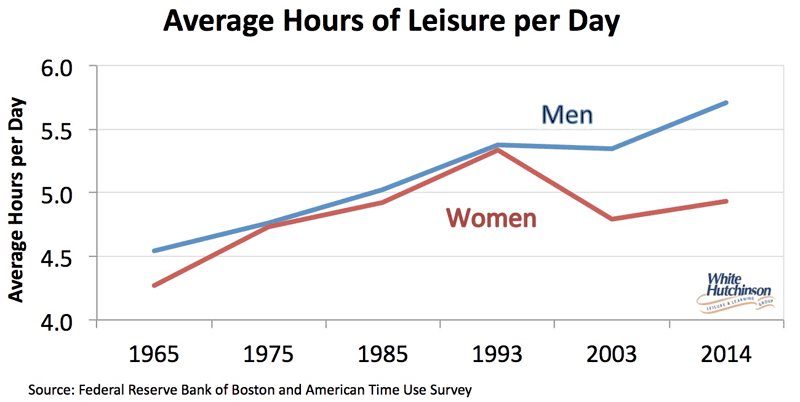
Obviously the feeling of time famine is not due to a decrease in leisure time, as just the opposite has occurred. Many time-use researchers argue that Americans' sense of time famine stems from an increasing emphasis on the consumption of experiences and a move away from buying stuff in the experience economy. People now derive more pleasure from enjoying and sharing an experience than buying a shiny watch or designer handbag. Experiences require time and people want to pack more experiences into the leisure time they have.
Our leisure time has become more fragmented and that is contributing to the feeling of time poverty. The leisure hours we have are increasingly broken up into rigid blocks, sort of like a television schedule, that may, individually, be too small to accommodate out-of-home leisure activities. So instead we are limited to shorter duration casual leisure activities at home. This of course limits our leisure choices and makes us feel we lack time for what we would like to do.
Time use researchers also argue that the phenomenon of “time deepening,” doing more and more things quickly and simultaneously is contributing to the feeling of time scarcity.
Time deepening
Time deepening is a shift from thinking of doing things in either-or terms - doing either one activity or another - to doing activities simultaneously. Time deepening can occur in four ways:
- Attempting to speed up a given activity, do it faster
- Substituting a leisure activity that can be done more quickly for one that takes longer
- Doing more than one activity at once - multitasking, especially using digital technology
- Undertaking a leisure activity with more precise regard to time - tight scheduling
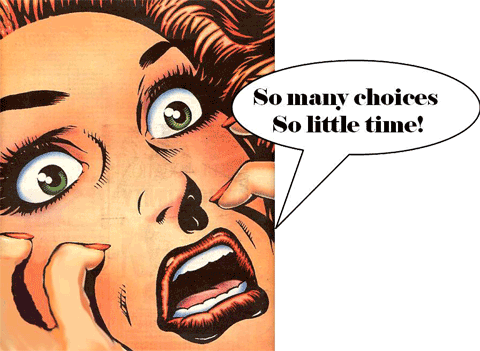
With time deepening, time, in effect, becomes transformed from a fixed commodity to one that can be stretched almost indefinitely. Today many people using time deepening are able to avoid the sacrifice of one activity for another, seeking instead to do it all and see it all, and do it and see it now and all at once. The emphasis is on cramming more into less time. Just think about someone watching a TV show, having a snack and texting to a friend. Or how about driving while drinking a coffee and talking to someone via a Bluetooth connection to your smartphone (this of course is not a safe multitasking practice). Some studies show that multitasking has added an average of more than seven hours to each day, that's 45% more effective time each waking day. However, research shows that each of those multitasking activities lack the quality they would have if done alone.
Leisure time inequity
As the income gap in the U.S. has widened, it's actually lower-wage workers who have ended up with the most leisure time, and it's the higher earners who report feeling the most time pressure. This is true even for couples in which only one spouse works outside the home. Time deepening is more prevalent among working higher socioeconomic Americans who have less leisure time than their lower socioeconomic and non-working counterparts.
Over the past decade, the amount of leisure time has increased. However, there continues to be a disparity between higher-educated/higher income and the lower-educated/lower income Americans.
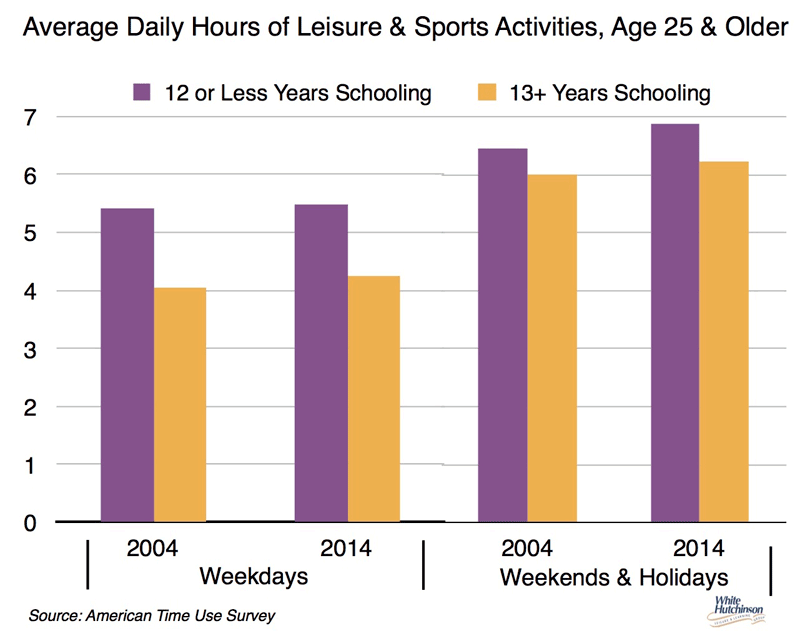
The leisure time inequality gap now stands at higher-educated adults having 74 fewer minutes of leisure time on weekdays and 38 fewer minutes on weekends and holidays than the less-educated adults.
Voracious consumption
Surprisingly, although higher-educated individuals enjoy less leisure time than lower-educated individuals, research shows that they engage in what is referred to as voracious consumption of leisure, a fast paced and intense participation in many types of out-of-home leisure, what you might call optimization of out-of-home leisure time. Voracious leisure consumption involves participation in a wide variety of out-of-home leisure activities and a high frequency of participation. This involves more activities being done simultaneously and shorter spells being spent on each activity, making the sequences more crowded and more fragmented, all leading to feelings of time pressure. The theory is that the income rich, time poor pursue voracious leisure consumption for a number of reasons including that it has become a marker of social status, replacing to a significant degree the status associated with the ownership of goods, and since the higher educated, higher income can afford out-of-home leisure experiences and there is now such a wide range of options, they want to do as many as possible in the limited time they have.
Research also shows that higher-educated adults, in addition to cramming more and more activities into their leisure time (their voraciousness), also spend more time with their spouse and with other adults (in social leisure), have a higher percentage of pure leisure and have longer continuous spells of leisure (although it may be fragmented among a number of activities) than lower-educated individuals. In other words, they have higher quality and more intense leisure.
The luxury of time
Luxury used to be all about owning some exclusive product, designer clothes, a fancy car or other expensive product. That is all changing in the experience economy with the increased emphasis on the consumption of experiences rather than buying and owning stuff. And with our shift in values of what is desired and most valued, time has now become the new luxury, as experiences require time to enjoy. The new luxury is all about getting the most out of our time. In fact higher socioeconomic consumers are more concerned about wasting their time then wasting their money. Time is replacing money as the most valued resource. And money is far less of a barrier to enjoying this new luxury. It is no longer something only accessible by the rich and affluent.
There are two options to time as the new luxury at a leisure venue: either take from people as little time as possible when they are there or maximize the experience during the time are there.
Piers Fawkes, Founder of PSFK, offers this observation about the luxury of quality leisure time today, “So it seems that getting the most out of time isn't about lavish parties or extreme experiences, but it's about spending time with loved ones - you know those times because they appear in the pics you see on Facebook: the friends who appear in the photos on that hike you took, or relatives at the once-a-year family get-together, or simply the day you took off to spend with the kids.”
Basically what Piers is suggesting is that enjoying the luxury of leisure time today is most about the time we spend socializing together with friends and family and sharing it on social media. The sharing is important to gaining social capital, which we used to get from the luxury goods we bought and owned.
Trading money for time
It's not hard to find examples of the progression of the increasing value we have placed of time today and a willingness to pay more to save time. One simple example is pancakes.
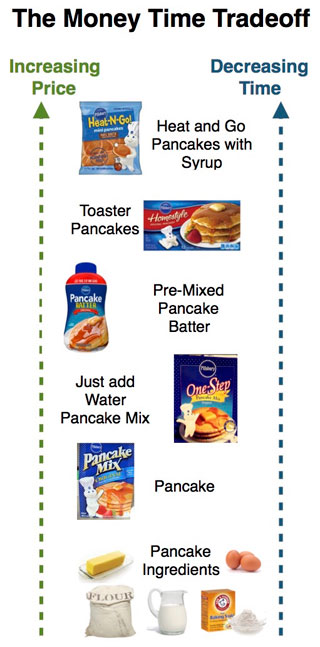
Not that many years ago, if you wanted some pancakes for breakfast, you had to buy and mix all the raw ingredients - flour, eggs, milk, salt, sugar, baking powder and butter - and then get out a pan, heat it on the stove and cook your pancakes. That took some time to gather up all the ingredients, mix up the batter, cook them and then clean up afterwards. Then along came Pillsbury pancake mix where you had to just add milk and eggs. That took less time, but still a lot. Then, to eliminate the need to have eggs and milk at home, a new one-step pancake mix only required adding water. That still took time to mix, cook and clean up. So to save more time, along came just squeeze the premade batter out of a bottle onto the hot pan option, so you didn't have to take the time to mix the batter. You still had to get out the pan, heat it and clean up afterwards. So, for what at one time we thought was the ultimate at-home timesaving option, along came microwavable pancakes. No pan, but we still need to take the time to sit down at the table to eat them and clean up our plate and utensils afterwards, at least put them in the dishwasher. So let's time deepen even more by multitasking with the latest Heat-N-Go option. Throw the bag in the microwave and then head out the door. We can eat them out of the bag as we drive to work listening to NPR's Morning Edition on the car radio. Yes, the Heat-N-Go pancakes cost a whole lot more than making them from scratch or any of the other options, but we are more than willing to trade money for time today.
The luxury of time as a competitive advantage
Restaurants, especially the non-table service ones, the fast food and fast casuals, are learning that the amount of time it takes to eat at their restaurants is becoming a barrier to their business success.
So now Starbucks with their Mobile Order & Pay allow you to place your order and pay ahead on the smartphone Starbucks app. You can walk into the store and without waiting in line, ask a barista for your freshly made order at the pickup area. Fast casual chains such as Panera and Which Wich are starting to offer the same option with their own apps.
At table service restaurants, time is also proving to be precious. One recent survey in the U.K. found 71% of customers limit their menu consideration to two or three choices to save time deciding on what to order and 70% of adults are frustrated by some aspect of waiting at restaurants, with the top five frustrations of all types with dining out dealing with waiting time.
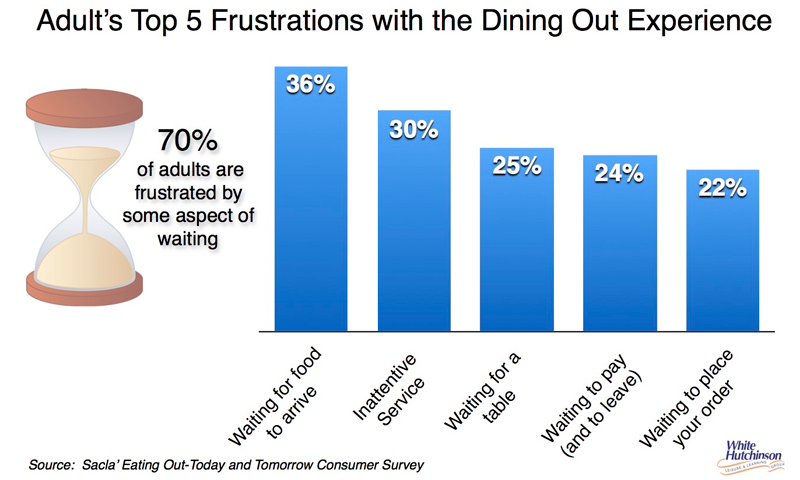
A bifurcated market
Since education levels are basically synonymous with income, what we are seeing is a bifurcated market for out-of-home location-based leisure (LBL). People who have the most leisure time can least afford to visit LBLs, if at all, while those with the higher incomes, the higher-educated, can afford LBL experiences but have the least leisure time to do so. Since the higher educated feel the most time pressured, they are seeking the highest quality leisure experiences and willing to pay a premium price for them.
The time requirement to attend an LBL is becoming an increasing barrier to visitation. Attending an LBL can easily require three hours when you factor in the time to get ready to go, drive, park and the time spent in the LBL. The fragmentation of our leisure time into fixed blocks means we often don't have three consecutive hours to do that. And then there is the risk the facility will be too crowded, so we might not be able to ride the go-karts or bowl without a long wait. So even when we do have three hours available, we worry that might not be enough time, and we decide not to go due to the risk factor, the anxiety, that our time won't achieve our goals. Safer and easier to just stay home.
Decreasing participation
Time famine appears to be contributing to a decline in attendance at out-home-home entertainment venues. Since 2003, average attendance by Americans age 15+ decreased by over one-quarter (-27%).
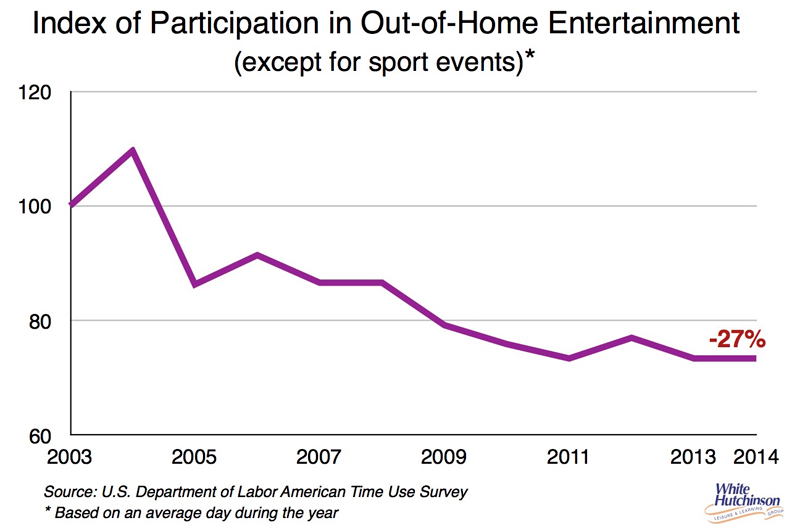
The movie theater industry has been experiencing a similar decline in attendance. Over that same 2003-2014 time period, North American per capita attendance has declined by almost one-quarter (-24%). Recognizing that time is an increasingly important part of the decision to go out to the movies, AMC Theatres, the second largest theater chain, is taking steps to minimize moviegoers' time to as little as possible and to maximize the movie going experience during the time that they are there. In many of their busiest theaters, they now offer reserved seating. There is no longer anxiety about whether you will get a seat for a popular movie or get a good seat. And with pre-paid reserve seating, you don't have to wait in the ticket line and can also save the time of watching all the previews and just arrive in time for the main feature.
AMC has now introduced another time saving service - an app to preorder and prepay for food and drinks on your smartphone before coming to theatre and then pickup your items at a pickup station. They are removing what they call the “popcorn pinch point,” the time moviegoers spend waiting in line at the concession stand. At theaters with reserved seating, AMC might even begin delivering orders placed in advance directly to people in their chairs.
And to maximize the value, the quality of the time watching the movie and the enjoyment, many theaters have installed cushy electric leather lounge chairs just like you might have at home when you watch some film on your HD big screen TV. This is in addition to enhanced digital projection and sound, 3D and IMAX offerings, which are now becoming standard. Oh, and just to make sure your time in the theater is at least as good as being home, the theaters now have bars so you can enjoy your favorite alcoholic drink while watching. And most now have greatly enhanced food options that go way beyond the traditional popcorn and candy. You can now enjoy dinner while watching the big screen, a great time deepening option.
How LBLs can stay competitive
Time famine and competition from digital at-home and mobile technologies are both challenging LBL businesses to stay relevant and competitive, now and even more so in the future as new at-home entertainment technologies such as virtual and augmented reality grow in adoption. Offering luxury time can be a competitive advantage for LBL. Just like movie theaters, to stay competitive, LBLs need to understand that time is the new luxury and take as little as possible from guests when they attend and for the time they do spend in the LBL, give them the most bang for their time, meaning the highest quality, the highest fidelity experience possible.
Innovations such as advance reservations for all the entertainment options enhancesan LBL appeal as it assures guests that they will efficiently use their disposable leisure time. Our company has several clients who have implemented reservations for all their major attractions and as a result, have seen their revenues go up by removing the anxiety about the amount of time visiting will require and knowing they can arrive precisely when they are scheduled.
The addition of destination dining with quality contemporary menu and bar offerings at an LBL is also a time saving feature, as a visit becomes a one-stop experience by combining eating, socializing and some fun. In fact, for attractions like bowling, you can time deepen all three simultaneously while down on the lanes.
Making the experience as social as possible is important, as leisure time researchers have found, the quality of leisure is partially measured by its social component. That is why one of the most social of all activities, sharing food and drink with friends or family, is so important to the mix.
Today and in the future, to remain an attractive out-of-home leisure option for today's consumers and competitive with all their other leisure options, including just staying home with their digital entertainment options, LBLs need to help their guests maximize the use of their leisure time by taking the least amount of time from them and giving them the highest quality experience during the time they do take from them. Time has become the new luxury offering, the new value equation for higher socioeconomic guests who are the most desired and profitable target market.
Vol. XVI, No. 1, January 2016
- Editor's corner
- Hedonic adaption - the curse of family entertainment centers
- Sometimes you just need to have a whole lot of patience
- Birthday University scholarship
- Time is the new luxury - a new competitive strategy
- The rise of tech-kids
- Corporate social responsibility - Its growing importance
- The scoop on service dogs; the law and your rights


